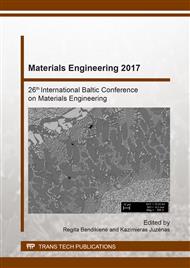[1]
U. S. B. of Standards, Copper wire tables. Washington: Govt. print. off., (1914).
Google Scholar
[2]
R. Ritasalo, M. Antonov, R. Veinthal and S.P. Hannula, Comparison of the wear and frictional properties of Cu matrix composites prepared by pulsed electric current sintering, Proc. Est. Acad. Scien. 63 (10) (2014) 62-74.
DOI: 10.3176/proc.2014.1.09
Google Scholar
[3]
O.F. Higuera-Cobos and J.M. Cabrera, Mechanical, microstructural and electrical evolution of commercially pure copper processed by equal channel angular extrusion, Mater. Sci. Eng. A, 571 (2013) 103-114.
DOI: 10.1016/j.msea.2013.01.076
Google Scholar
[4]
J. Pirso, M. Viljus, S. Letunovitš, K. Juhani and R. Joost, Three-body abrasive wear of cermets, Wear, 271 (11) (2011) 2868-2878.
DOI: 10.1016/j.wear.2011.06.005
Google Scholar
[5]
B. Yao, Z. Han and K. Lu, Correlation between wear resistance and subsurface recrystallization structure in copper, Wear 294 (2012) 438-445.
DOI: 10.1016/j.wear.2012.07.008
Google Scholar
[6]
D.A. Rigney and S. Karthikeyan, The evolution of tribomaterial during sliding: a brief introduction, Tribol. Lett. 39 (1) (2010) 3-7.
DOI: 10.1007/s11249-009-9498-3
Google Scholar
[7]
Y. Champion and H.J. Fecht, Nano-Architectured and Nanostructured Materials: Fabrication, Control and Properties. Publisher John Wiley & Sons 2006, (2006).
DOI: 10.1002/3527606017
Google Scholar
[8]
N. Lugo, N. Llorca, J.J. Suñol and J. M. Cabrera, Thermal stability of ultrafine grains size of pure copper obtained by equal-channel angular pressing, J. Mater. Sci. 45 (9) (2010) 2264-2273.
DOI: 10.1007/s10853-009-4139-7
Google Scholar
[9]
L. Kommel and A. Pokatilov, Electrical conductivity and mechanical properties of Cu-0. 7 wt. % Cr and Cu-1. 0 wt. % Cr alloys processed by severe plastic deformation, IOP Conf. Ser. Mater. Sci. Eng. 63 (1) (2014) 12169-12176.
DOI: 10.1088/1757-899x/63/1/012169
Google Scholar
[10]
A.P. Zhilyaev, A. Morozova, J.M. Cabrera, R. Kaibyshev and T.G. Langdon, Wear resistance and electroconductivity in a Cu–0. 3Cr–0. 5Zr alloy processed by ECAP, J. Mater. Sci. 52 (1) (2017) 305-313.
DOI: 10.1007/s10853-016-0331-8
Google Scholar
[11]
L. Kommel, Tribological behavior at dry sliding by electric current of Cu-Cr-S alloy after equal channel angular pressing, Key Eng. Mater. 721 (2016) 430-435.
DOI: 10.4028/www.scientific.net/kem.721.430
Google Scholar
[12]
L. Kommel, N. Pardis and E. Kimmar, Micromechanical properties and electrical conductivity of Cu and Cu-0. 7wt% Cr alloy, Proceedings of 9th International DAAAM Baltic Conference Industrial Engineering, (2014) 354-359.
Google Scholar
[13]
R.K. Islamgaliev, K.M. Nesterov, J. Bourgon, Y. Champion and R.Z. Valiev, Nanostructured Cu-Cr alloy with high strength and electrical conductivity, J. Appl. Phys. 115 (19) (2014) 194301-194301-4.
DOI: 10.1063/1.4874655
Google Scholar


